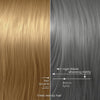
Hair Aging – Science & Maintaining Young Hair
4 min reading time

4 min reading time
Discover the science behind hair aging . Learn how biology, antioxidants, and professional treatments help maintain young, strong, and shiny hair.
The Science of Hair Aging – How to Maintain Young Hair
Just like skin, hair ages. It becomes drier, thinner, and less shiny. But hair aging isn't a mystery—it's biology. By understanding the science, we can slow, prevent, and even partially reverse the signs of aging. Professional expertise makes it possible to maintain "young hair," regardless of age.
1. What exactly is hair aging?
Hair aging is a combination of internal and external processes that affect the hair follicle and fiber.
✔ Internal factors: hormonal changes, reduced blood circulation, genetic aging of the follicle.
✔ External factors: UV radiation, oxidative stress, chemical treatments, air pollution.
The result is thinner, duller, more brittle hair with reduced elasticity.
At the molecular level, the production of keratin, melanin, and lipids decreases. This disrupts the balance of strength, color, and shine.
2. The role of melanin – color loss over the years
Melanin determines hair color. With age, melanin production in melanocytes slows down.
✔ Less melanin → gray or white hair.
✔ Melanocyte depletion is irreversible, but can be slowed by antioxidants.
✔ UV-filtering products prevent further oxidation of pigment.
Professional advice: Use products with vitamin E, polyphenols or UV protectors to slow down color loss.
3. The influence of hormones and hair follicle aging
Estrogen stimulates hair growth. After the ages of 35–40, this hormone gradually declines, shortening the anagen phase (growth phase) .
✔ The follicle shrinks → hair becomes thinner.
✔ The hair shaft contains less keratin.
✔ Blood circulation to the scalp is reduced.
Professional support: massages, serums with caffeine, niacinamide or peptides can stimulate microcirculation and activate the follicle.
4. External aging: damage from environment and styling
Oxidative stress (caused by UV, smoke and pollution) leads to free radicals that attack keratin chains.
✔ The cuticle becomes rough.
✔ The cortex loses moisture and structure.
✔ The shine disappears.
Antioxidants and lipid-rich formulas (such as argan or marula oil ) help to limit this damage.
5. The role of nutrition and lifestyle
Hair is a reflection of the body.
✔ Proteins (keratin, collagen) → building material.
✔ Iron, zinc, selenium → hair follicle support.
✔ Omega 3 fatty acids → shine and suppleness.
✔ Stress management → lower cortisol levels, healthier hair growth.
Professional advice: combine salon treatments with holistic advice – nutrition, sleep, supplements.
6. Active anti-aging ingredients
Modern formulas contain anti-aging complexes that act on the biology of the hair:
✔ Peptides & amino acids – stimulate keratin production.
✔ Niacinamide & caffeine – improve microcirculation of the scalp.
✔ Panthenol & hyaluronic acid – hydrate and restore elasticity.
✔ Plant stem cells & antioxidants – protect against oxidative stress.
✔ Vegan keratin & ceramides – strengthen the structure.
These ingredients slow down structural aging and restore shine.
7. Professional treatments with anti-aging effect
✔ Hair Botox & Bioplastia – replenish lost mass and restore suppleness.
✔ Nanoplastia – protects against oxidative stress and UV.
✔ Scalp serums with peptides – extend the growth phase of the follicle.
✔ Hydrating treatments with hyaluronic acid – restore the elasticity of the fiber.
Combined, they form an anti-aging protocol for hair – science translated into results.
Conclusion: Young hair starts with knowledge, not age
Aging is inevitable, but its speed is controllable. By combining science and care, we can help hair function more youthfully —stronger, shinier, more vibrant. Because beauty isn't timeless, it's scientifically optimized.